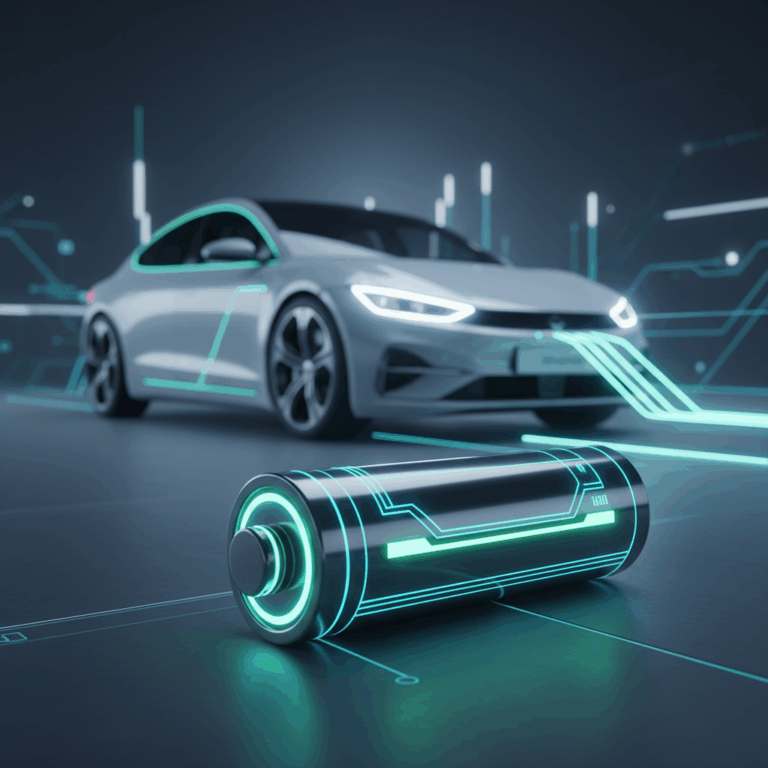Current status and dominant technologies
In 2025, innovation in electric car batteries is at a crucial juncture, with lithium-ion as the dominant technology. This type of battery still holds a majority of the market thanks to its efficiency and performance.
However, new technologies seek to overcome historical barriers such as range, charging time, and cost, promising a significant transformation in electric mobility within a few years.
These innovations not only improve energy capacity but also enhance battery safety and sustainability, which are critical to the future of electric transportation.
Lithium-ion battery technology
Lithium-ion batteries continue to be the mainstay of the market due to their high energy density and reliability. They are the standard for most current electric vehicles.
These batteries store energy through the movement of lithium ions between the anode and cathode, offering good autonomy and suitable recharge times for the end user.
Although its technology is constantly advancing, its potential is limited by factors such as material costs and recycling challenges.
Historical limitations and challenges
Lithium-ion batteries face challenges such as limited battery life, long recharge times, and high production costs, hindering wider adoption.
The use of liquid electrolytes poses safety risks, including flammability, prompting the search for safer and more efficient alternatives.
Furthermore, the dependence on scarce materials and the environmental impact associated with manufacturing and disposal hinder the long-term sustainability of this technology.
Key innovations in electric car batteries
Innovations in electric car batteries are transforming the industry, with new technologies that promise greater range and safety. These solutions seek to overcome the current limitations of traditional batteries.
In 2025, advances such as solid-state batteries and sodium-ion chemistry stand out, offering a safer and more sustainable alternative to conventional lithium batteries. Innovation also extends to recycling and design.
These improvements propel electric mobility toward a future with more affordable vehicles, significantly reduced charging times, and lower environmental impact—key to the global energy transition.
Solid-state batteries
Solid-state batteries use solid electrolytes instead of liquid ones, increasing their energy density by up to 50% compared to traditional batteries. This allows for ranges of up to 800 km on a single charge.
Thanks to their lower internal resistance, these batteries enable ultra-fast recharging, reaching an 80% charge in less than 10 minutes, and also improve safety by reducing fire risks.
Although still in the prototype and limited production phase, these batteries are expected to be commercially available between 2026 and 2028, marking a decisive advance in electric mobility.
Sodium ion chemistry
Sodium-ion chemistry takes advantage of the abundance and low cost of sodium, a more economical and sustainable alternative to lithium. These batteries do not yet match the energy density of lithium-ion, but are ideal for urban vehicles.
They are emerging as a promising option for democratizing access to electric cars, reducing dependence on geopolitically problematic materials and opening up new possibilities in mobility.
Currently in the testing phase, sodium-ion batteries could significantly contribute to a more accessible and environmentally friendly market in the coming years.
Silicon anodes and recycling
The use of silicon anodes increases storage capacity, as silicon can hold more lithium ions than traditional graphite, increasing the range of electric vehicles.
In addition, they combine advances in recycling that facilitate the recovery of valuable materials, reducing the environmental impact over the battery's life cycle and promoting its sustainability.
This innovation represents a key step toward improving the performance and environmental friendliness of batteries, aligning with global emissions reduction goals.
New battery pack designs
Designs are evolving toward “cell-to-pack” and “cell-to-chassis” configurations, eliminating intermediate structures to reduce weight and cost, making batteries more compact and efficient.
Integrating the cells directly into the vehicle body optimizes space and improves range, while also facilitating the manufacturing and assembly of these energy systems.
These design innovations contribute to lighter and more affordable electric vehicles, accelerating mass adoption and improving the end-user experience.
Impact of innovation on the market and sustainability
Battery innovations are transforming the market, enabling more affordable electric cars with greater range and reduced recharging times. This is driving the widespread adoption of electric mobility.
Furthermore, sustainability has become a key focus, with advances that minimize the environmental footprint throughout the battery lifecycle, from manufacturing to recycling.
Improvements in autonomy, recharging and cost
Solid-state batteries offer up to 50% more energy density, extending range up to 800 km, reducing charging anxiety for users.
Charging time is also drastically reduced, with the 80% charging in less than 10 minutes, making it comparable to refueling a conventional car.
At the same time, new designs and chemistries such as sodium-ion contribute to lower production costs, making electric vehicles more accessible and competitive in the market.
Reducing environmental impact
The increasing use of silicon anodes and improved recycling processes facilitate material recovery, reducing mining and battery-related waste.
Emerging technologies seek to reduce dependence on scarce and toxic metals, promoting greener and more sustainable alternatives in the supply chain.
These advances not only meet regulatory requirements but also improve public perceptions of the environmental responsibility of electric mobility.
Prospects and future of batteries for electric cars
The future of electric vehicle batteries is characterized by the coexistence of established and emerging technologies, which together will drive global electrification.
While lithium-ion batteries maintain their dominance, new chemistries and designs are advancing greater efficiency, safety, and sustainability in the automotive market.
In this context, regulatory developments and expanding global adoption will be key factors in accelerating the transition toward cleaner and more accessible mobility.
Coexistence of established and emerging technologies
Lithium-ion batteries will remain the mainstay of the market in the coming years thanks to their reliability and mature production. At the same time, technologies such as solid-state and sodium-ion will gain ground.
This coexistence will allow us to leverage diverse strengths: lithium-ion expertise and production capacity, along with the innovative advantages of new chemistries and designs.
Parallel development facilitates a gradual transition that will reduce risks and encourage technological adaptation across different applications and market segments.
Regulatory influences and global adoption
Environmental regulations, such as the ban on combustion vehicles in Europe starting in 2035, are driving innovation and the widespread adoption of electric cars and advanced batteries.
Government incentives and global climate commitments are accelerating demand, encouraging investment in research, production, and recycling for a more sustainable market.
This regulatory and technological convergence creates an enabling environment for improved batteries to achieve greater range, faster charging, and lower environmental impact worldwide.







